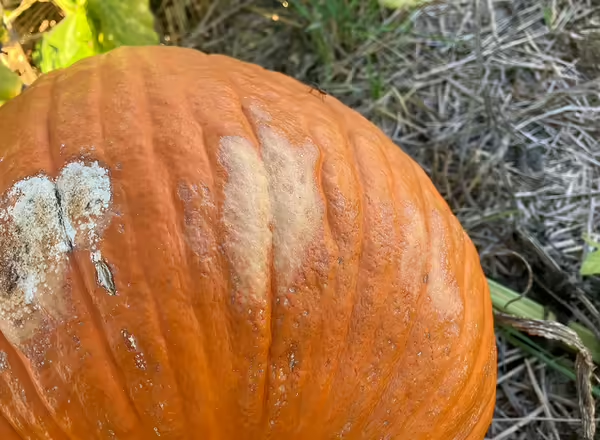
The 2025 pumpkin season is now mostly in the books for most growers, so I wanted to look back at some of the observations and challenges of the season.
The early wet weather in May and then drought would probably be the biggest challenges. Where the drought and heat were most intense, we did see reduced fruit size on some varieties, but later fruit set did regain some of the size. Overall, quality was very good (other than the size issue, mentioned) the limited moisture did leave us with limited bacterial spot and fruit rot issues. The extended heat of July and August put some stress on pumpkins outside of the dry conditions.
No downy mildew was reported this year, and I was happy with powdery mildew control with preventative fungicides. My last spray was the last day of August, and I could find no signs of infection as of then. About 2 weeks later I did see some very scattered signs of disease, but as it was mid-September, harvest was underway, and I didn’t feel the need to spray again. We did get some powdery mildew on leaves later in September, but even to date it never progressed to the point of getting on pumpkin stems, which at this point in the season is the only concern I have.
Sunscald was problematic, as the intense sun and heat continued into October, leaving harvested pumpkins in the field much more than a week could run the risk of some getting burnt. No different than you or I, when a pumpkin is removed from under the leaves that is has been growing under and exposed to direct, intense sun, the side of the fruit in the most direct sun gets burned since it did not grow under those high light conditions. Now if a fruit has been exposed to the light all the time, it’s not as bad but commonly we see sunscald when 1)harvested pumpkins are left out in direct sun, 2)when the plant canopy suddenly gets damaged (defoliated by disease for example, also drought stress and leaf wilting and canopy loss can be in play) and the fruit are suddenly exposed to light. With average September/October temperatures sunscald isn’t too bad, but with the consistent days of sun and above normal temperature through most of September and early October like we have had this year, it can show up. I don’t have a good index, but different varieties are also more sensitive than others to sunscald. I have also seen this from retail displays, especially those out early in September, that have the pumpkins sitting out in the full sun. Again, our conditions this year make this worse.
After sunscald happens, it opens the fruit up to secondary infection from common disease pathogens, not different than if it was carved or cut into. Best recommendations I have is to do your best to keep the canopy healthy and then after harvest don’t leave the fruit out in the field or in direct sun for an extended time. Just from experience, sometimes a week or so cut in the field can be ok during heat/sun like we had, but much more than that and sometimes you can start seeing even harvested fruit showing a few signs of sunscald.
The marketing season was pretty good with a weekend rain in southern Illinois in late October but otherwise the weather was good for most of our agritourism activities. One downside to the marketing season was the warm temperatures did not put people in the mood for fall even into early October, but as the calendar passed most people still gave in to decorate even if it was a little warm.
Overall, it has been a great season and now we shift our focus on to the 2026 pumpkin season!

